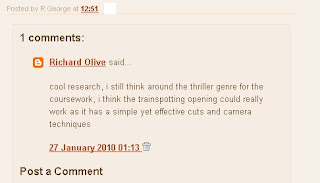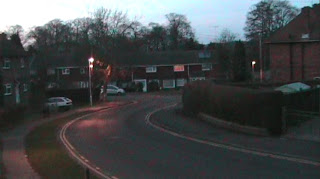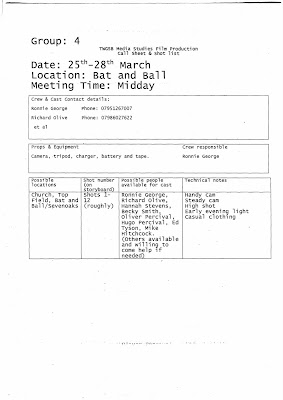Wednesday, 12 May 2010
Friday, 7 May 2010
[RO] Q2) Representation
[RO] Q3) Distribution
This is question 3) of the evaluation
[RG] Evaluation Q4-Q7

Q6) Through the course I’ve picked up a lot of new technology based skills that I previously would have been unable to do. To make the film it was necessary to pick up techniques for filming and editing otherwise the piece would have been harder to make and of lower quality. Working on a blog was a highly efficient way of managing group work and keeping bits up to date while approaching the deadline. On the blog we were able to work together as a group and comment on new posts.
 It was a good way to get ourselves prepared for filming. Once our filming began we took the camera out to our original location with the tripod and looked for good places to set up shots. We always considered how the framing would make the shot look through rule of thirds and if the lighting was effecting the picture or continuity. One problem we faced on our first shoot was it got dark too quickly.
It was a good way to get ourselves prepared for filming. Once our filming began we took the camera out to our original location with the tripod and looked for good places to set up shots. We always considered how the framing would make the shot look through rule of thirds and if the lighting was effecting the picture or continuity. One problem we faced on our first shoot was it got dark too quickly.
Fortunately we were able to overcome this by changing the contrast in editing. We used the editing to change the filters on every shot to give the piece its own “feel” that fitted the genre. When comparing our production to the production of a real film the work was done in the same order with our audience research and location ideas coming way first before filming and finally editing the shots/sounds.
Q7) When we initially filmed our preliminary task we were unfamiliar with using the cameras and weren’t 100% on how to film what we wanted effectively. We only did each shot once for the preliminary which meant we had to cut it very short to edit out the bad angles/lighting. The preliminary was very helpful in the long run despite me seeing it as a waste of time at first. It was the base for us learning how to handle the camera and plan out our shots and it also taught us about how to pace running and cutting to keep the footage visually interesting. By filming our preliminary as a chase scene when we came to filming another chase scene for the actual opening we had a good idea of what looks good. By having used slow pans and handy cam shots before we were able to do them more effectively and with enough ease that would could put extra effort into making sure the shots were just right. We learnt a lot about continuity editing in our preliminary task and used this knowledge effectively in deciding where to cut our final opening. The planning time in between doing the preliminary task and the film opening was extremely helpful.
[RG] Feedback Questionnaire
For our last question people were asked if they had any comments on the film but unfortunatly no one answered.
Thursday, 6 May 2010
Wednesday, 5 May 2010
[RG] Call Sheet & Risk Assessment

<-- This is our call sheet. The call sheet helped us organise who we would meet and where we were planning the shoot. It was filled out before we rented our camera equipment so that we were able to pre-plan the shoots and make sure everyone involved knew their job and when/where to arrive.
Wednesday, 28 April 2010
Monday, 26 April 2010
Evaluation proposal
Not finished, will improve and lenghen post when finished and am happy with the answers to the evaluation questions. Its probably time to start thinking in which media we will answer each question. I think question 4 and 5 should be text based with stills inserted (charts from SurveyMonkey?) and question 7 should be voice over of short clips from the priliminary and opening, should probably start editing that very soon.
Thursday, 22 April 2010
Tuesday, 20 April 2010
[Group] rough cut comments
With this piece of work. the critisisms with it were the style and tempo of music didnt really grip onto the media to make it feel like a chase scene, so we completely developed a new soundtrack, in which i e-mailed Sony and asked to use the media, which was kasabian - Reason for Treason.
Monday, 19 April 2010
Wednesday, 24 March 2010
[Group] Current status of Coursework
Richard emailed Sony regarding using the track "Reson is Treason" by Kasabian, which we decided fits well with the theme of our genre and the pace of our cutting. The song can be heard on Youtube here: http://www.youtube.com/watch?v=qfuT1VUKARk (from 0:08)
Title and Fonts
Richard also found a new font to use for the title on the opening and has started modifying and editing the font in Premier to make it more visually appealing and fit into the title sequence. We've chosen to use the sound piece from the last post (RO - Sound, 16 March 2010) to put together with the titles as they fade onto the screen.
Future Shoots
We've planned out all missing shots and things we want to reshoot and have organized the order and times we want to shoot them in. New locations have been thought of that will make the opening more interesting and we hope to include a few shots we haven't used yet to keep the piece from becoming boring. After discussion with our teachers we've fully organized everything we need to do and everywhere we have to go to completre shooting and have the footage ready for editing in time to meet the deadline.
Tuesday, 16 March 2010
RO - Sound
[RG] Shoot 13/3/10
Location: Otford
Equipment used: Camera, Tripod
The tripod was used for most of the shots to achieve effective panning and steady-cam shots. When shooting I had to consider the rule of thirds and how visualy noisy the cars cars make the shot.
Thursday, 4 March 2010
Preliminary Task
We set out to film a chase sequence through continuity editing,
The continuity editing was a success but we would like to improve the quality of the camera work and the fluent movement between the shots
Wednesday, 24 February 2010
Tuesday, 9 February 2010
Preliminary Task
Friday, 5 February 2010
[RG] Opening Analysis
-The film opens with a steady cam shot of two characters running away from security in a busy street. At first, the audience doesn't know why they are running.
-The camera cuts to ground level and you can see the feet of the main character as he runs and objects falling to the ground from his pockets. The audience can then deduce that the man has just robbed somewhere.
-There is a low angled shot as the man runs down a small set of stairs which snaps to a point of view angle of him running down the road.
-This point of view switches to another point of view shot of a driver as he hits the man in his car.
-A name title pops up and then there is the first cut to a new scene of him smoking.
-This cuts to a scene of characters playing football where their name titles are shown.
-There are then continuous cuts between the smoking scene and the football scene as the main character falls down.
-The whole opening is accompanied by narration as there is no other dialogue and the tone and words used set the theme of the movie. The song Lust for Life by Iggy Pop is also constantly accompanying the opening and gives the footage an upbeat, late 80s/90s feel, that is effective at fitting the theme and running sequence.
Wednesday, 3 February 2010
RO - The preliminay task
Friday, 29 January 2010
[RG] Group - Discussion 28/01/10
Wednesday, 27 January 2010
RO - Theme music for opening
Group - Discussion 26/01/10
RO - Camera Work
run into a bit of trouble with the chair as it was difficult to steer therefore i fell of it but everything worked out as we found out that we took a risk by shooting the thin path in the quite area and not the path leading from the art block.
Tuesday, 26 January 2010
[RG] Opening concept - Stephen King's IT
The link: http://www.youtube.com/watch?v=ZcW_FbNG1cg
Watch from 0:00 - 3:13
[RG] Genre Analysis - Horror
2. Early horror movies are largely based on classic literature of the Gothic/horror genre, such as Dracula, Frankenstein, The Phantom of the Opera and Dr. Jekyll and Mr. Hyde. A sub-genre of horror is the slasher film, usually with a teenage cast and targeted towards a teenage audience, so a good direction of the genre for our group to look into.
3. Horror films are designed to frighten and to invoke our hidden worst fears, often in a terrifying, shocking finale, while captivating and entertaining us at the same time in a cathartic experience. Horror films feature a wide range of styles, from the earliest silent Nosferatu classic, to today's CGI monsters and deranged humans. They are often combined with science fiction when the menace or monster is related to a corruption of technology, or when Earth is threatened by aliens.
4.
Villain




Victim


5. The location of Horror can be practically anywhere, from widely populated cities to more commonly small, barely populated villages. One location often found in horrors is the large, old fashioned building that is usually haunted or abandoned.
6. The essence of horror is the violent, unanticipated disruption of audience trust in moral and natural order, but modern “horror” are less about horror and more about iconography. The horror genre is a flood of movies featuring zombies, vampires, werewolves, swamp creatures and Frankenstein who's analogues have supplanted the superhero as the dominant mainstream figure.


7.Costume
8. By changing the angle and placement of lights, you can turn an everyday scene into something horrifying. While these techniques are ideal for horror, they can also be used to add suspense or an air of mystery to an otherwise ordinary scene.
Low-key lighting is a style of lighting for photography, film or television. It tends to heighten the sense of alienation felt by the viewer, hence is commonly used in film noir and horror genres.
9. Here are a few fonts found on 1001freefonts.com that would suit the Horror genre:

RO - Technical Analysis of Trainspotting opening
The Scene starts with a close up steady shot of the main male character running towards the camera to convey a sense of mystery, for example running from something.
Then the Camera cuts to his feet to show items falling out which conveys theft while showing people running behind in suits conveying security.
Then a medium low shot to show the actor running from a near side on view.
Then a low angled Shot to a follow sweep to follow the male down the stairs.
A POV shotto show the character running as if someone is following him or chasing him.
Then a mid shot to show from the cars POV and the male sliding over the cars bonnet for him then to stop.
A Mid shot of the character smoking,
Then a long shot of the male character smoking,
A long shot of the teams of footballthen shots of the football with titles of the characters names.
A continuity shot between two scenes of him falling down.
Narration shows the story at the beginning but also gives you a view that this is going to be a teen thriller.
Music has a high tempo to convey running as its an upbeat lifting song but also creates an britpop feel through the music to create a film based on the 1980's
I have learnt from this that you can create a simple opening yet it will be very effective, the narrative drives the film as it explains what he does in which we want to know more.
RO - Genre Analysis - Thriller
Vladimir Nabokov who taught at cornell university said that "In an Anglo-Saxon thriller, the villain is generally punished, and the strong silent man generally wins the weak babbling girl, but there is no governmental law in Western countries to ban a story that does not comply with a fond tradition, so that we always hope that the wicked but romantic fellow will escape scot-free and the good but dull chap will be finally snubbed by the moody heroine"
There was connotations of earlier thrillers in "Homer's Odyssey."
"The genre is a fascinatingly flexible form that can undermine audience complacency through a dramatic rendering of psychological, social, familial and political tensions and encourages sheltered but sensation-hungry audiences, in Hitchcock's phrase, "to put their toe in the cold water of fear to see what it's like." Quote From Source
Thrillers include assasination, jeprody, murder, mass murder and terrorism.
Sub Genres of Thrillers
Action Thriller - The Transporter(Leterrier, 2002)
Conspiracy Thriller - JFK (Stone, 1991)
Crime Thriller - Seven (Fincher, 1995)
Disaster Thriller - World trade centre (Stone, 2006)
Drama Thriller - The illusionist (Burger, 2006)
Erotic Thriller - Basic Instinct (Verhoeven, 1992)
Legal Thriller - The Firm (Pollack,1993)
Medical Thriller - Awake (Harold, 2007)
Political Thriller - The Agency (Kaczender, 1980)
Psychological Thriller - The Good Son (Ruben, 1993)
Spy Thriller - The Bourne Identity (Liman, 2002)
Techno Thriller - The Hunt for Red October (Mctiernan, 1990)
Religious Thriller - The Di Vinci Code (Howard, 2006)
Science Fiction Thrillers - Alien (Scott, 1979)
Text source:
http://en.wikipedia.org/wiki/Thriller_(genre)






